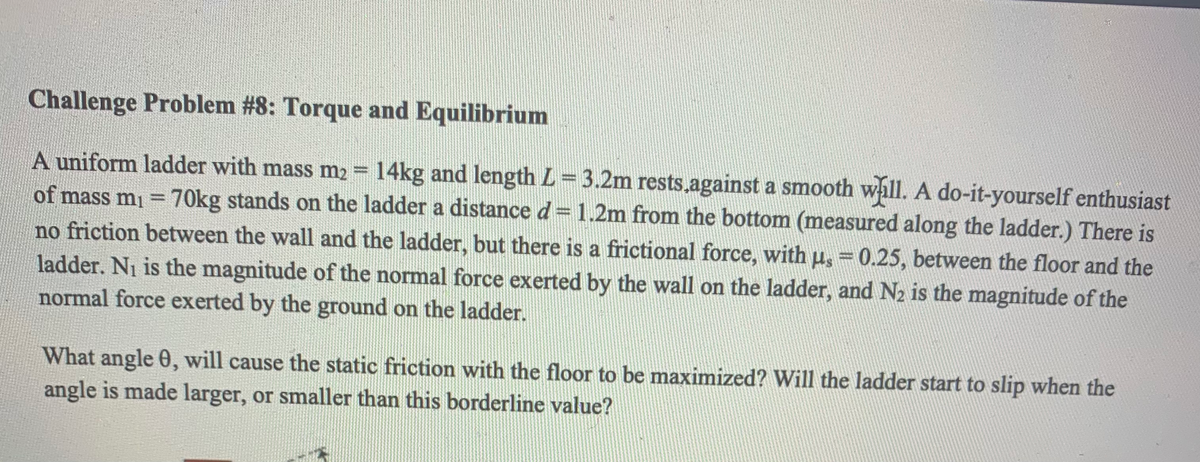A uniform ladder with mass m2 = 14kg and length L= 3.2m rests,against a smooth wall. A do-it-yourself enthusia of mass mi = 70kg stands on the ladder a distance d = 1.2m from the bottom (measured along the ladder.) There is no friction between the wall and the ladder, but there is a frictional force, with u, =0.25, between the floor and the ladder. Ni is the magnitude of the normal force exerted by the wall on the ladder, and N2 is the magnitude of the normal force exerted by the ground on the ladder. %3D
A uniform ladder with mass m2 = 14kg and length L= 3.2m rests,against a smooth wall. A do-it-yourself enthusia of mass mi = 70kg stands on the ladder a distance d = 1.2m from the bottom (measured along the ladder.) There is no friction between the wall and the ladder, but there is a frictional force, with u, =0.25, between the floor and the ladder. Ni is the magnitude of the normal force exerted by the wall on the ladder, and N2 is the magnitude of the normal force exerted by the ground on the ladder. %3D
Principles of Physics: A Calculus-Based Text
5th Edition
ISBN:9781133104261
Author:Raymond A. Serway, John W. Jewett
Publisher:Raymond A. Serway, John W. Jewett
Chapter10: Rotational Motion
Section: Chapter Questions
Problem 74P: A stepladder of negligible weight is constructed as shown in Figure P10.73, with AC = BC = ℓ. A...
Related questions
Question

Transcribed Image Text:Challenge Problem #8: Torque and Equilibrium
A uniform ladder with mass m2 = 14kg and length L= 3.2m rests.against a smooth wall. A do-it-yourself enthusiast
of mass mi = 70kg stands on the ladder a distance d= 1.2m from the bottom (measured along the ladder.) There is
no friction between the wall and the ladder, but there is a frictional force, with u, = 0.25, between the floor and the
ladder. Ni is the magnitude of the normal force exerted by the wall on the ladder, and N2 is the magnitude of the
normal force exerted by the ground on the ladder.
What angle 0, will cause the static friction with the floor to be maximized? Will the ladder start to slip when the
angle is made larger, or smaller than this borderline value?
Expert Solution
This question has been solved!
Explore an expertly crafted, step-by-step solution for a thorough understanding of key concepts.
This is a popular solution!
Trending now
This is a popular solution!
Step by step
Solved in 2 steps with 1 images

Recommended textbooks for you

Principles of Physics: A Calculus-Based Text
Physics
ISBN:
9781133104261
Author:
Raymond A. Serway, John W. Jewett
Publisher:
Cengage Learning

College Physics
Physics
ISBN:
9781285737027
Author:
Raymond A. Serway, Chris Vuille
Publisher:
Cengage Learning

Physics for Scientists and Engineers: Foundations…
Physics
ISBN:
9781133939146
Author:
Katz, Debora M.
Publisher:
Cengage Learning

Principles of Physics: A Calculus-Based Text
Physics
ISBN:
9781133104261
Author:
Raymond A. Serway, John W. Jewett
Publisher:
Cengage Learning

College Physics
Physics
ISBN:
9781285737027
Author:
Raymond A. Serway, Chris Vuille
Publisher:
Cengage Learning

Physics for Scientists and Engineers: Foundations…
Physics
ISBN:
9781133939146
Author:
Katz, Debora M.
Publisher:
Cengage Learning

College Physics
Physics
ISBN:
9781305952300
Author:
Raymond A. Serway, Chris Vuille
Publisher:
Cengage Learning

Physics for Scientists and Engineers with Modern …
Physics
ISBN:
9781337553292
Author:
Raymond A. Serway, John W. Jewett
Publisher:
Cengage Learning

Glencoe Physics: Principles and Problems, Student…
Physics
ISBN:
9780078807213
Author:
Paul W. Zitzewitz
Publisher:
Glencoe/McGraw-Hill